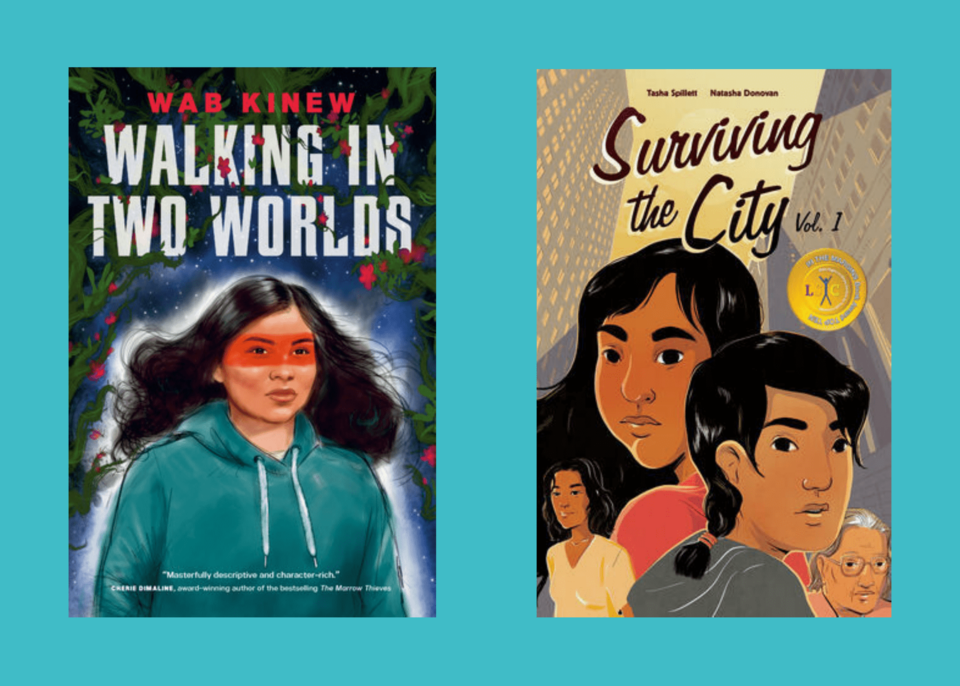The project of decolonization requires readers, young and old, to diversify the stories they consume.
Earlier this month IndigiNews explored a list of kids books written and illustrated by Indigenous creators, and we highlighted the need for children’s books that embrace diversity and Indigenous identity.
To encourage our readers to keep reading, IndigiNews Education and Child Welfare Storyteller Jenessa Joy Klukas has compiled a list of young adult fiction books that can capture the hearts and minds of Indigenous and non-Indigenous Youth alike (and maybe even adults too).
These fiction books feature Indigenous protagonists and a wide range of storylines that explore everything from dystopian futures, to current issues, to coming of age.
Walking in Two Worlds by Wab Kinew
Walking in Two Worlds follows Anishinaabe teen, Bagonegizzhigok – or Bugz as she’s most often called – who is a gamer caught between two worlds, both real and virtual. Set in the future where virtual worlds are part of everyday life, Bugz plays in the “floraverse,” where her avatar is confident and dominant, and a far cry from who she is in the real world – a shy youth dealing with the stresses of teenage angst and life on the Rez.
Wab Kinew is a bestselling author, a member of the Midewin, and was an Honorary Witness during the Truth and Reconciliation Commission of Canada (a witness is generally a keeper of history for significant events). He currently resides in Manitoba and is a provincial politician.
The Barren Grounds by David A. Robertson
The Barren Grounds follows the story of two Indigenous kids, Morgan and Eli who, having been forced away from their families and communities, wind up living together in a foster home in Winnipeg. They both struggle to fit in at school and in their new home, but they eventually find a secret portal to another reality. The publisher, Penguin Randomhouse, describes the book as “Narnia meets traditional Indigenous stories of the sky and constellations.”
David A. Robertson is a member of the Norway House Cree Nation, and won a Governor General’s Literary Award in 2017 for his book When We Were Alone.
The Marrow Thieves by Cherie Dimaline
The Marrow Thieves is a dystopian novel that explores a future where the world is almost completely destroyed due to climate change. Indigenous Peoples are hunted for their bone marrow, as it contains the cure to something that most of humanity has lost – the ability to dream. Frenchie, a dynamic protagonist, and his companions, flee northwards to hide and survive.
Cherie Dimaline is a writer, editor and a registered and claimed member of the Metis Nation of Ontario. Her award-winning fiction has been published internationally and she received numerous awards for The Marrow Thieves, including the 2017 Governor General’s Literary Award in the Young People’s Literature category.
Surviving the City by Tasha Spillett, illustrated by Natasha Donovan
Surviving the City is a graphic novel set in Winnipeg that follows two best friends, Miikwan and Dez, who do everything together. But when Dez’s Grandmother becomes ill, she’s told she may have to move into a group home. To avoid such a fate, she disappears, leaving Miikwan devastated. This graphic novel explores themes of friendship, colonialism, womanhood and the anguish of a missing loved one.
Tasha Spillett, is a Inninewak (Cree) and Trinidadian woman who calls on her bloodlines for her strength in the work she does.
This Place: 150 Years RetoldMultiple authors and illustrators.
This Place is a graphic novel anthology that explores Indigenous perspectives through ten stories that combine fiction and non-fiction. Familiar stories and characters can be found in these pages – such as Métis businesswoman Annie Bannatyne, Louis Riel, the impact of the Sixties Scoop, and the “child welfare system.” This book also contains themes of magic realism, serial killings, psychic battles and time travel.
Jenessa Joy Klukus, Local Journalism Initiative Reporter, The Discourse


